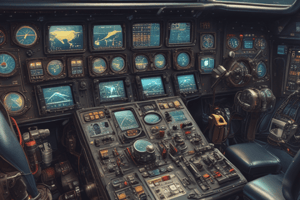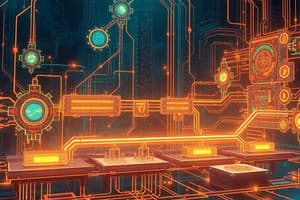Podcast
Questions and Answers
What is the component that measures the process variable and feeds it back to the controller?
What is the component that measures the process variable and feeds it back to the controller?
- Sensor (correct)
- Actuator
- Setpoint
- Error
Which component compares the process variable to the setpoint and decides on corrective action?
Which component compares the process variable to the setpoint and decides on corrective action?
- Actuator
- Error
- Controller (correct)
- Sensor
What is the difference between the process variable and the setpoint called?
What is the difference between the process variable and the setpoint called?
- Error (correct)
- Setpoint
- Proportional control
- Feedback
Which type of control adjusts the actuator based on the size of the error?
Which type of control adjusts the actuator based on the size of the error?
What does integral control adjust based on, in addition to the error?
What does integral control adjust based on, in addition to the error?
What is the device that applies corrective action known as?
What is the device that applies corrective action known as?
What type of control adjusts the actuator based on the rate of change of the error?
What type of control adjusts the actuator based on the rate of change of the error?
Which control mode offers robustness and flexibility by combining proportional, integral, and derivative controls?
Which control mode offers robustness and flexibility by combining proportional, integral, and derivative controls?
What does a Proportional-Integral (PI) control combine?
What does a Proportional-Integral (PI) control combine?
In aircraft flight control systems, what is the main function?
In aircraft flight control systems, what is the main function?
What is the primary goal of smart grids?
What is the primary goal of smart grids?
Why are control systems important in various industries and applications?
Why are control systems important in various industries and applications?
Flashcards are hidden until you start studying
Study Notes
Understanding Control Systems
Control systems are the backbone of many systems and processes we encounter daily, ensuring stability, efficiency, and safety. In simple terms, a control system uses sensors to monitor a process, compares it with a desired setpoint, and then makes corrections using actuators to maintain the desired state. Let's dive into the fundamental aspects and applications of control systems.
Components of a Control System
-
Process variable (PV): This is the quantity being controlled, such as temperature, pressure, or speed.
-
Setpoint (SP): The desired value of the process variable.
-
Controller: The hardware or software component that compares the process variable to the setpoint and decides on corrective action.
-
Actuator: The device that applies the corrective action.
-
Sensor: The device that measures the process variable and feeds it back to the controller.
-
Feedback: The process of comparing the process variable to the setpoint and applying corrective action.
-
Error: The difference between the process variable and the setpoint.
Control Modes
-
Proportional control: The controller adjusts the actuator based on the error, but the adjustment is proportional to the size of the error.
-
Integral control: The controller adjusts the actuator based on the error and the time the error has existed, helping to eliminate offset errors.
-
Derivative control: The controller adjusts the actuator based on the rate of change of the error, providing responsiveness to sudden changes.
-
Proportional-Integral (PI) control: A common combination of proportional and integral control.
-
Proportional-Integral-Derivative (PID) control: A combination of all three control modes, offering robustness and flexibility.
Control Systems Applications
Control systems are prevalent in various industries and applications:
-
Aircraft flight control systems: Automatically maintaining a desired altitude, heading, and speed.
-
Automobile cruise control: Maintaining a constant speed while driving.
-
Autopilot systems: Assisting in the navigation and control of ships and airplanes.
-
Smart grids: Ensuring the stability and efficiency of power grids by balancing supply and demand.
-
Production lines: Maintaining a consistent production rate and quality in manufacturing processes.
Control systems are vital in ensuring the performance, efficiency, and safety of various systems and processes. Understanding the fundamental components, control modes, and applications of control systems equips us with the knowledge to appreciate the wide range of applications and advancements in this field.
Studying That Suits You
Use AI to generate personalized quizzes and flashcards to suit your learning preferences.



